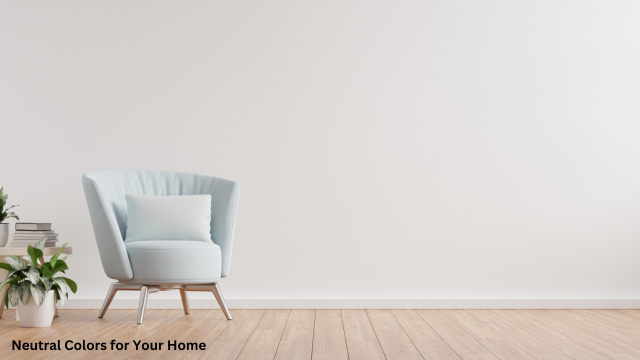The allure of neutral colors in home decor Neutral colors have long been a staple in the world of interior design, captivating homeowners and design enthusiasts alike with their timeless elegance and versatility. From the soothing serenity of soft grays to the warm embrace of beiges and taupes, these understated hues have the power to transform any space, creating a harmonious and inviting atmosphere that transcends passing trends.
As an experienced designer, I have witnessed firsthand the enduring appeal of neutral colors in home decor. These colors possess a unique ability to serve as a blank canvas, allowing homeowners to experiment with various design styles, textures, and accents without overwhelming the senses. Whether you prefer a minimalist, contemporary aesthetic or a cozy, traditional vibe, neutral colors can seamlessly adapt to your personal style preferences.
Understanding the concept of neutral colors
Recognizing the idea of neutral hues Colors that are in between white, black, grey, beige, and brown are frequently referred to as neutral hues. The reason these colors are referred to as “neutral” is that they can easily be combined and blended with a broad spectrum of other colors because they lack a strong undertone of any particular hue.
Calm, sophistication, and timeless appeal are frequently linked to neutral color schemes. For other design components, like artwork, textiles, and accessories, they offer a calming and tranquil background that lets them shine. Neutral color schemes allow you to express your creativity and individuality while still creating a unified and harmonious aesthetic throughout your house.
The psychology behind neutral colors in interior design
The psychology behind neutral colors in interior design The psychological impact of neutral colors in interior design cannot be overstated. These colors have a calming and grounding effect on the senses, helping to create a sense of tranquility and relaxation within a space. Studies have shown that neutral hues can help reduce stress, promote focus, and even improve mood and well-being.
Moreover, neutral colors are often perceived as sophisticated and elegant, lending a sense of refinement and timelessness to any space. By choosing neutral palettes, homeowners can create a sense of visual balance and harmony, allowing the eye to rest and appreciate the overall design aesthetic.
The versatility of neutral colors in different spaces
The versatility of neutral colors in different spaces One of the greatest advantages of neutral colors is their versatility. These colors can be seamlessly incorporated into a wide range of spaces, from cozy living rooms to airy bedrooms and even functional kitchens and bathrooms.
In the living room, neutral colors can provide a soothing backdrop for comfortable seating areas, allowing pops of color in the form of throw pillows, artwork, or area rugs to take center stage. In the bedroom, neutral hues can create a serene and restful environment, promoting a sense of relaxation and rejuvenation.
In the kitchen and bathroom, neutral colors can lend a timeless and sophisticated look, complementing a variety of design styles, from modern and minimalist to traditional and rustic. By using neutral tones as a foundation, homeowners can easily incorporate various textures, materials, and finishes to enhance the overall aesthetic.
Choosing the right neutral color palette for your home
Choosing the right neutral color palette for your home When it comes to selecting the perfect neutral color palette for your home, it’s essential to consider the overall design aesthetic, the amount of natural light in the space, and your personal preferences.
For a more modern and minimalist look, opt for crisp, clean whites, soft grays, and muted beiges. These colors can create a sense of openness and airiness, while still maintaining a sophisticated and refined feel.
If you prefer a warmer and more inviting atmosphere, consider earthy tones like taupes, creams, and warm browns. These colors can lend a cozy and comforting ambiance to any space, while still maintaining a sense of elegance.
It’s also important to consider how the neutral colors will interact with the other design elements in your home, such as wood tones, metal finishes, and textiles. By carefully curating your neutral color palette, you can create a cohesive and harmonious design that reflects your personal style.
Incorporating neutral colors in walls, furniture, and accessories
Incorporating neutral colors in walls, furniture, and accessories Once you’ve selected your neutral color palette, it’s time to start incorporating these timeless hues into your home’s design. Begin with the walls, as they serve as the foundation for the entire space. Opt for soft, muted shades of gray, beige, or white to create a serene and calming backdrop.
Next, consider your furniture choices. Neutral-toned sofas, chairs, and tables can provide a versatile and timeless foundation for your living spaces. Complement these pieces with textured throw pillows, cozy blankets, and natural fiber rugs to add depth and visual interest.
In the bedroom, choose a neutral-toned bed frame, dresser, and nightstands to create a cohesive and calming retreat. Incorporate soft, natural textiles like linen, cotton, and wool to enhance the overall sense of relaxation and comfort.
Finally, don’t forget to incorporate neutral colors into your home’s accessories and decor. Vases, candles, artwork, and decorative objects in shades of white, gray, and beige can help tie the entire space together, creating a harmonious and visually appealing design.
Adding pops of color to enhance neutral color schemes
Adding pops of color to enhance neutral color schemes While neutral colors provide a timeless and sophisticated foundation, they can also serve as the perfect backdrop for adding pops of color. By carefully selecting accent colors that complement your neutral palette, you can create a visually striking and dynamic design.
Consider incorporating vibrant hues through throw pillows, artwork, or even a statement-making area rug. These colorful accents can add a touch of personality and energy to your neutral-toned spaces, without overwhelming the overall aesthetic.
Alternatively, you can introduce subtle pops of color through your choice of textiles, such as curtains, upholstery, or decorative throws. These soft, muted hues can help to add depth and visual interest to your neutral color scheme, while still maintaining a cohesive and harmonious look.
Timeless neutral color combinations for different design styles
Timeless neutral color combinations for different design styles One of the greatest advantages of neutral colors is their ability to adapt to a wide range of design styles, from modern and minimalist to traditional and rustic.
For a contemporary and sophisticated look, consider pairing crisp white with sleek, charcoal gray accents. This combination can create a sense of clean, modern elegance that is both timeless and on-trend.
If you prefer a more traditional aesthetic, try combining warm beige tones with rich, earthy browns. This classic color palette can lend a cozy and inviting ambiance to any space, while still maintaining a sense of timeless sophistication.
For a more rustic or farmhouse-inspired design, incorporate natural wood tones and soft, muted greiges (a blend of gray and beige) to create a harmonious and inviting atmosphere. This color scheme can be further enhanced with the addition of natural textures and materials, such as linen, jute, and woven accents.
Regardless of your preferred design style, neutral colors can serve as a versatile and timeless foundation, allowing you to experiment with different color combinations and design elements to create a space that truly reflects your personal aesthetic.
Tips for maintaining a cohesive and elegant look with neutral colors
Tips for maintaining a cohesive and elegant look with neutral colors Achieving a cohesive and elegant look with neutral colors requires a bit of planning and attention to detail. Here are some tips to help you maintain a harmonious and visually appealing design:
- Establish a consistent color palette: Choose a primary neutral color, such as white, gray, or beige, and use it as the foundation for your design. Incorporate complementary neutral tones throughout the space to create a cohesive and balanced look.
- Vary the textures: To add depth and visual interest to your neutral color scheme, incorporate a variety of textures, such as plush fabrics, natural materials, and metallic accents. This can help to prevent your space from feeling flat or one-dimensional.
- Introduce subtle patterns: While you want to avoid overwhelming the space with busy patterns, incorporating subtle, neutral-toned patterns can add a touch of visual interest and depth to your design. Consider using patterned throw pillows, area rugs, or wallpapers to achieve this effect.
- Incorporate natural elements: Bringing in natural elements, such as potted plants, wood accents, or natural fiber accessories, can help to warm up a neutral color scheme and create a more inviting and organic feel.
- Pay attention to lighting: Proper lighting can have a significant impact on the way your neutral colors are perceived. Utilize a combination of ambient, task, and accent lighting to enhance the depth and dimension of your neutral palette.
By following these tips, you can create a cohesive and elegant neutral color scheme that will stand the test of time and provide a timeless foundation for your home’s design.
Embracing the timeless elegance of neutral colors in your home
Embracing the timeless elegance of neutral colors in your home As an experienced designer, I firmly believe that the timeless elegance of neutral colors is a true gift to the world of interior design. These understated hues possess the power to transform any space, creating a harmonious and inviting atmosphere that transcends passing trends.
By embracing the versatility and sophistication of neutral colors, homeowners can craft a design that reflects their personal style while maintaining a sense of timeless sophistication. Whether you prefer a modern, minimalist aesthetic or a cozy, traditional vibe, neutral colors can seamlessly adapt to your preferences, serving as a versatile canvas for your design vision. Discover the true potential of neutral colors in your home and elevate your interior design with our expert guidance. Contact us today to schedule a consultation and start your journey towards a timeless and elegant living space.










